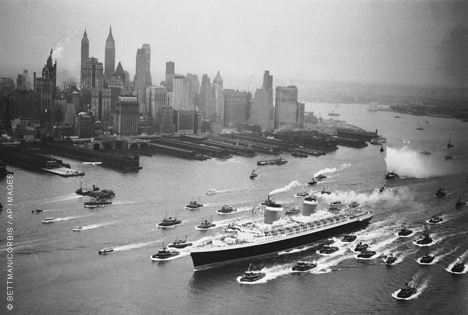
Steven Ujifusa GFA’05 first saw the S.S. United States in 1996 as a high-school student when, on a college scouting trip to Penn with his family, he crossed the Walt Whitman Bridge. Nudging his grandmother, he pointed out the once-stately passenger liner, moored in the Delaware River below, its paint chipped, its bottom rusted.
For years, Judith Follmann had regaled her young grandson with stories of her transatlantic voyages aboard the United States, QE 2, and Ile de France. The tales of card games and fine wines, dancing and adventure so instilled a love of ocean liners in Ujifusa that when he ultimately chose to pursue graduate studies in historical preservation and real-estate development at Penn (following an undergraduate degree in history at Harvard), the hulking presence of the United States was a distinct draw.
Then, in 2007, having just written a story about the ship’s impending demise for PlanPhilly (the online magazine from Penn’s School of Design), he got a rare chance to climb onboard.
“It was amazing to stand on the bridge from where the captain commanded the fastest ship ever,” recalls Ujifusa, now 33. “In the first-class ballroom with its circular dance floor stripped to almost nothing, I thought about my grandparents dancing there as Duke Ellington led the orchestra.”
A literary agent suggested he focus on the story of the ship’s designer, Philadelphia-born William Gibbs. The resulting book proposal sold within months, and last summer Simon & Schuster published A Man and His Ship: America’s Greatest Naval Architect and His Quest to Build the S.S. United States. Ujifusa celebrated with a real launch party, leading friends and preservationists out in a boat to view the ship’s rotting hull as it stood forlornly in the Delaware River.
On her maiden voyage in 1952, the United States easily broke the transatlantic speed record held by England’s Queen Mary, reducingthe crossing time by nearly 10 hours. It was the largest and most expensive American ship ever built, representing the handiwork of some 3,000 people, who outfitted it with everything from custom-made gold-leaf murals to two sculptural funnels, the largest ever installed on a passenger ship.
“No detail was overlooked,” says Ujifusa. “She had it all, raw power, awesome size, and sheer good looks.”
The passion he brings to his subject is enhanced by his simple, non-academic style (a fondness for footnotes aside), in which he allows the meteoric rise and dogged determination of his chosen hero to drive the story. That tale begins on a drizzly November day in 1894 as the eight-year-old Gibbs stands with 25,000 others outside the gates of Philadelphia’s Cramp Shipyard, watching the launch of the steamship St. Louis. From that day forward, Ujifusa writes, the “bookish, sickly” Gibbs “began thinking and reading of nothing but ships.”
He went to Harvard but was “miserable in Cambridge,” writes Ujifusa. “Terrified of being bullied, he kept the door to his room locked to protect his blueprints and ship photographs from mockery and practical jokes.” Withdrawing from the college in his second year, Gibbs promptly sailed to England with his brother Frederic, riding the Cunard’s Lusitania (which would be sunk by a German torpedo in 1915) and returning on the maiden voyage of its sister ship, the Mauretania. While passengers enjoyed “newfangled electric elevators and the lounge with its frosted glass dome,” the Gibbs brothers marveled at the steam turbines that kept the whole thing moving.
At 29, Gibbs won the financial backing of J.P. Morgan as he attempted to design the largest and fastest ship in the world. Though that project was waylaid by the advent of World War I, Gibbs and his brother began to get noticed, and eventually set up their own shipbuilding outfit. By 1942, Gibbs had arrived. Hailed on the cover of Time magazine as a “technological revolutionist,” he designed and oversaw the construction of more than 70 percent of all US naval ships during World War II.
The United States was originally intended to transport troops. Built under the auspices of the US Navy—which paid for two-thirds of its cost—the shipwas conceived of as an unsinkable “anti-Titanic,” says Ujifusa. In the years after its launching in 1952, it would carry, instead of soldiers, such notable civilians as the Duke and Duchess of Windsor, Salvador Dali, and an 18-year-old Bill Clinton, en route to his Rhodes Scholarship stint at the University of Oxford.
Ujifusa’s novelistic attention to detail earned admiring reviews from the likes of The Wall Street Journal, which chose the book as one of the year’s 10 best nonfiction titles. He says he drew inspiration from writers like E.L. Doctorow, Erik Larson C’76, and David McCullough, “popular historians and novelists who know how to craft narratives and bring to life a whole era through a central personality.”
In Gibbs he discovered a “forgotten American builder, on par with Frank Lloyd Wright and John Augustus Roebling,” Ujifusa says, adding: “I also saw some of Steve Jobs in him: a brilliant visionary and a ruthless project manager.”
Ujifusa’s own success reflects a similar single-minded determination. He traveled the country in search of passengers and crew members, mined newspaper articles and biographies, and uncovered a trove of Gibbs’ papers at the Mariners’ Museum in Newport News, Virginia.
“That was the mother lode,” he says. “I had been so worried that most of the story had gotten lost.”
Like Gibbs, Ujifusa benefited from good timing and an ability to pique the interest of people in a position to help him. “I was very lucky to start my research when the ship was in great jeopardy,” he says.
Mothballed in 1969 as the airplane age took off, the United States was reduced to a mere shell by the mid-1980s, its interior fittings scavenged or auctioned off. Since then, it has been sold and passed from hand to hand, alternately buoyed by efforts to reuse it and buffeted by threats to send it to the scrap yard.
Although he’s not directly involved in the ship’s fate at this point, Ujifusa once served on the board of the S.S. United States Conservancy, an organization devoted to finding a home (and a use) for the ship.
“There’s a good chance it will be salvaged,” he says. “Saving it represents a very, very challenging project and it requires people with great vision—but it just can’t be lost.”
As for his own future, well, there’s another book crying to get out.
“I can’t reveal what it is just yet,” he says, “but it will also be about Americans thinking big.” —JoAnn Greco




